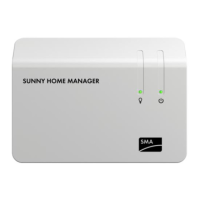Procedure:
• In the field Programmability, activate the required checkbox:
Setting Explanation
Yes After the start, the load runs through a defined program. Interrupting the
load during the course of the program can affect the operation result and
should therefore be avoided.
Examples: dryer, toaster
No The load always carries out the same function during operation. Multiple
switching on and off per day does not cause any problems. The load does
not have to run permanently - as long as a minimum operation time per
day is achieved, interruption of operation has no negative effect on the
function being carried out.
Examples: pond pump, heating element, water heater
9.3.6 Entering the Load Name
Using the load name, you can identify the loads in the SunnyHomeManager system.
Load name requirement:
☐ The load name can have a maximum of 23 characters.
Procedure:
• Enter a load name in the text field Name of Load, e.g. Washing machine basement.
9.3.7 Entering the Power Consumption
The power consumption is the average power typically required by a load for operation (see load
manual).
The SunnyHomeManager takes account of this value in the initial calculation of the required
energy.
Once the load provides measured values of its actual consumption during operation, the
SunnyHomeManager can determine a more precise power value after a learning phase. This
way, the SunnyHomeManager gradually improves its load planning and increases energy and
cost savings.
Procedure:
• Enter the power of the load connected in the text field Power Consumption.
9.3.8 Entering the Maximum Program Operating Time
The maximum program runtime is the time that a program-controlled load requires for its longest
program. The maximum program operating time defines the latest time at which a load must be
switched on so that its longest program can be completed within the specified time limits.
9 Load Control
SMA Solar Technology AG
User ManualHoMan_Portal-BA-en-2082

